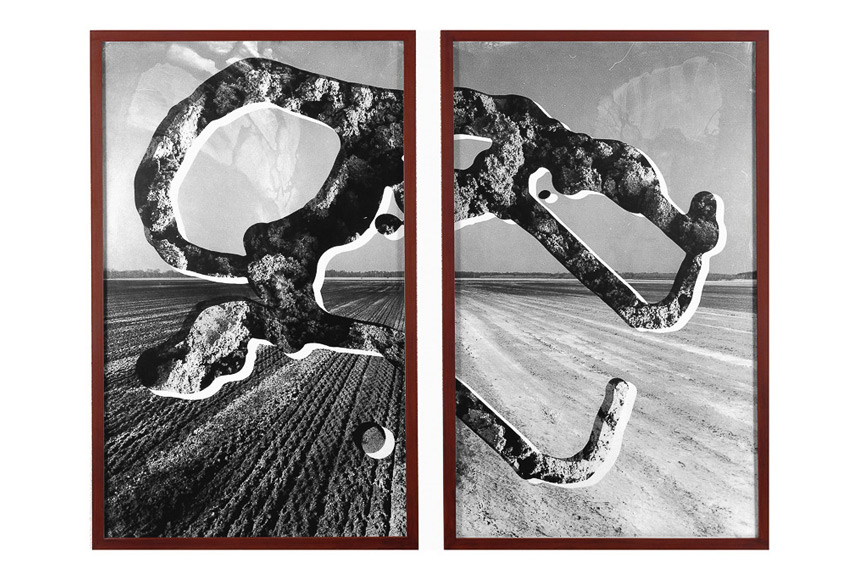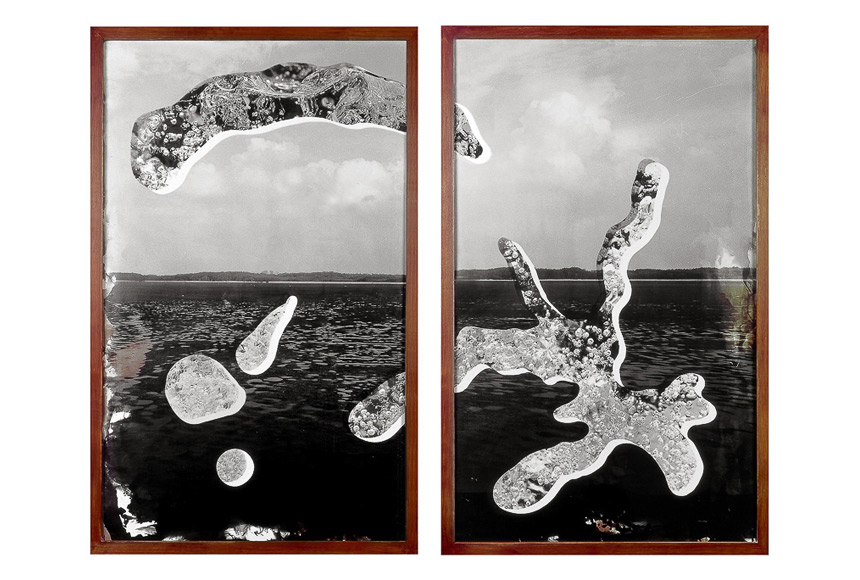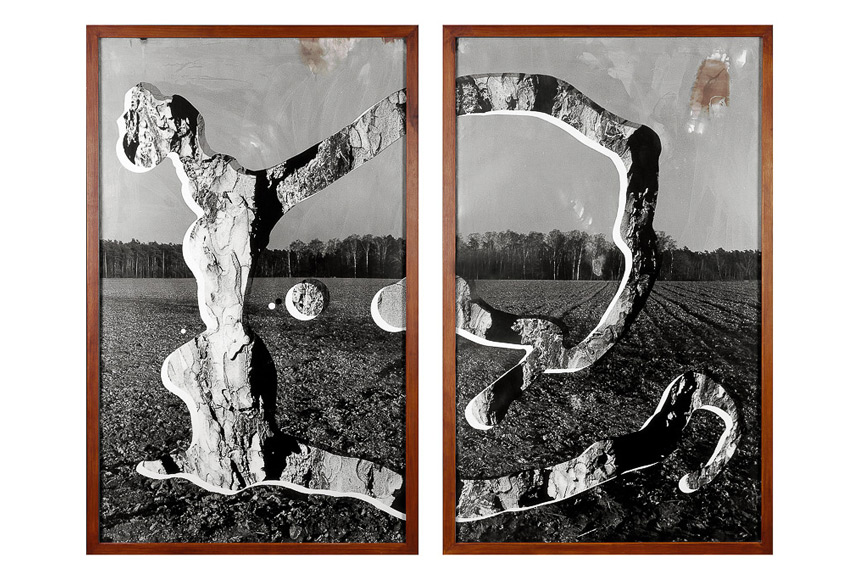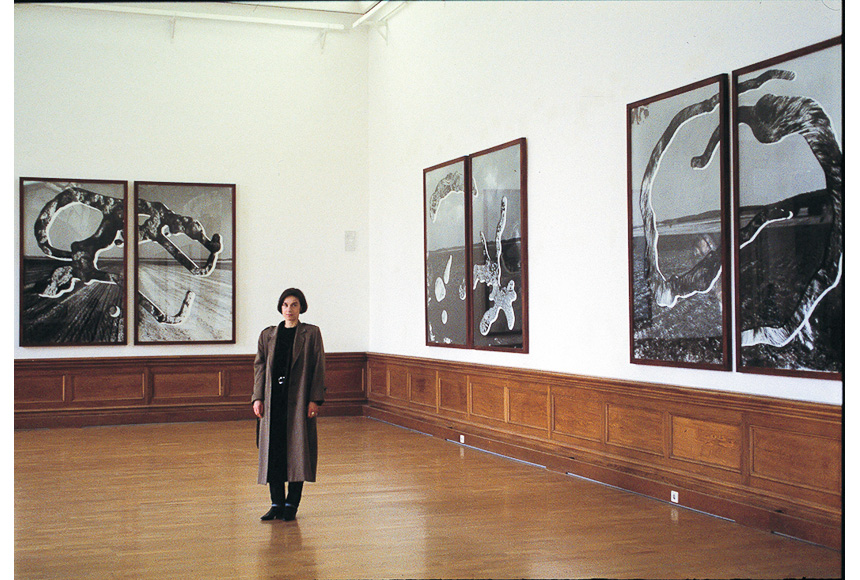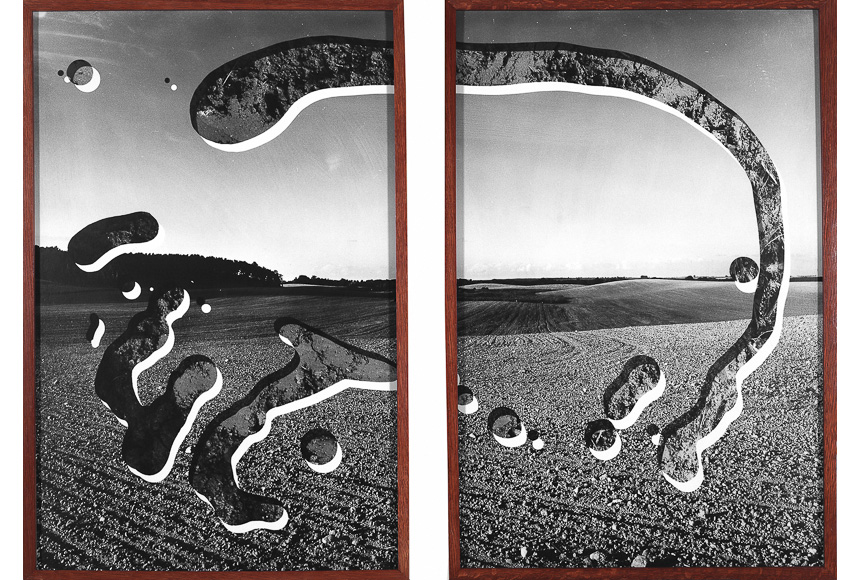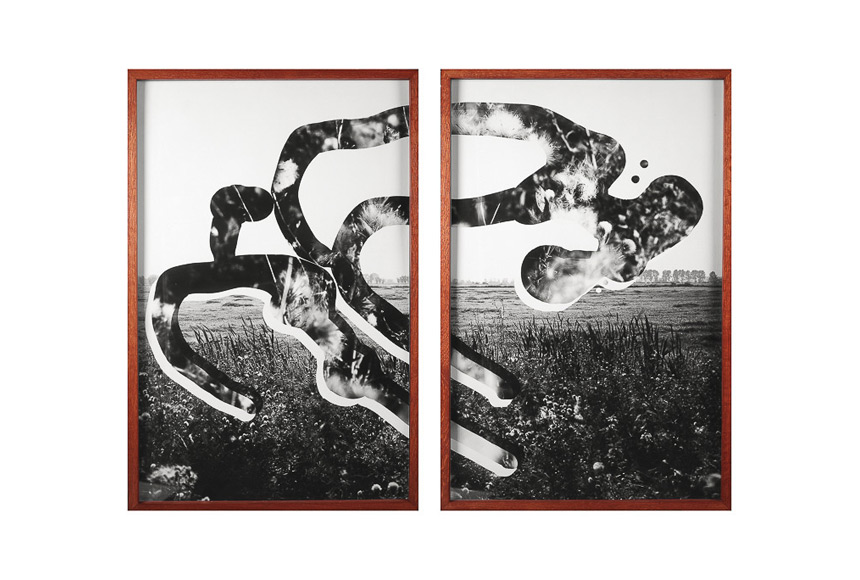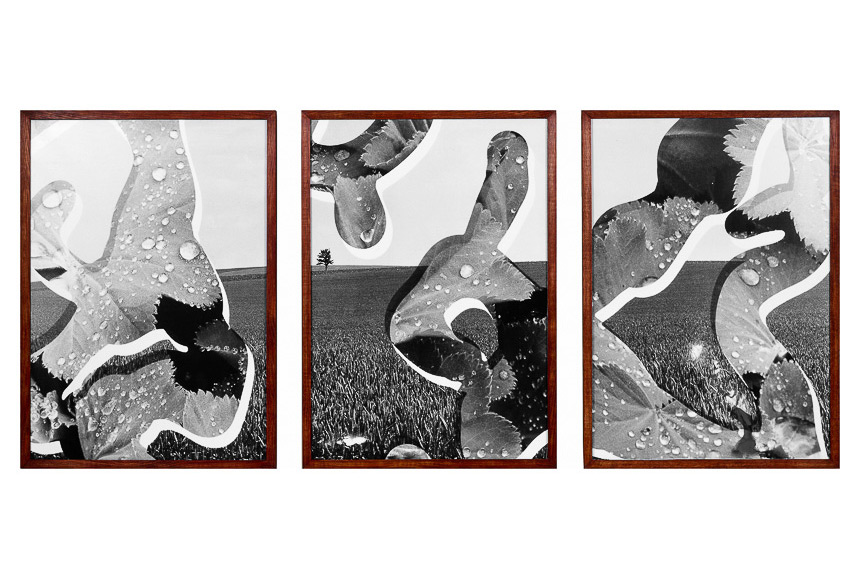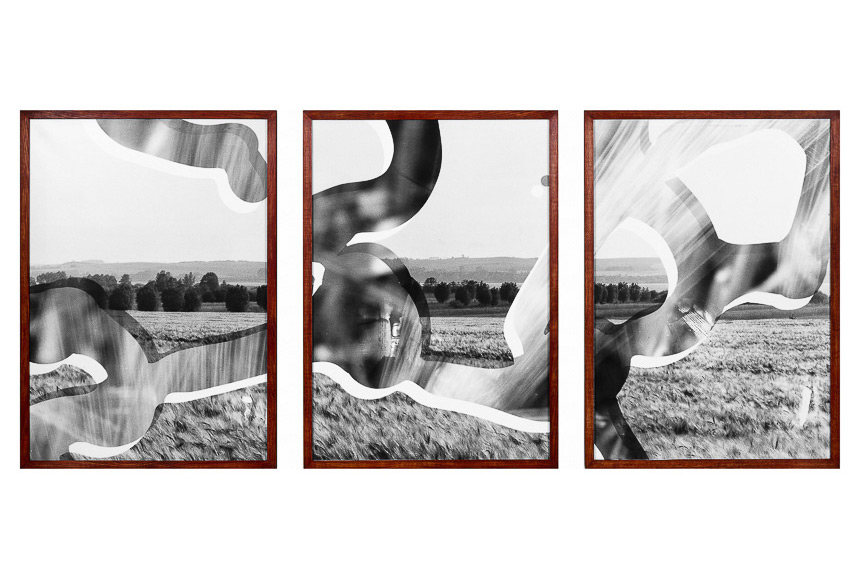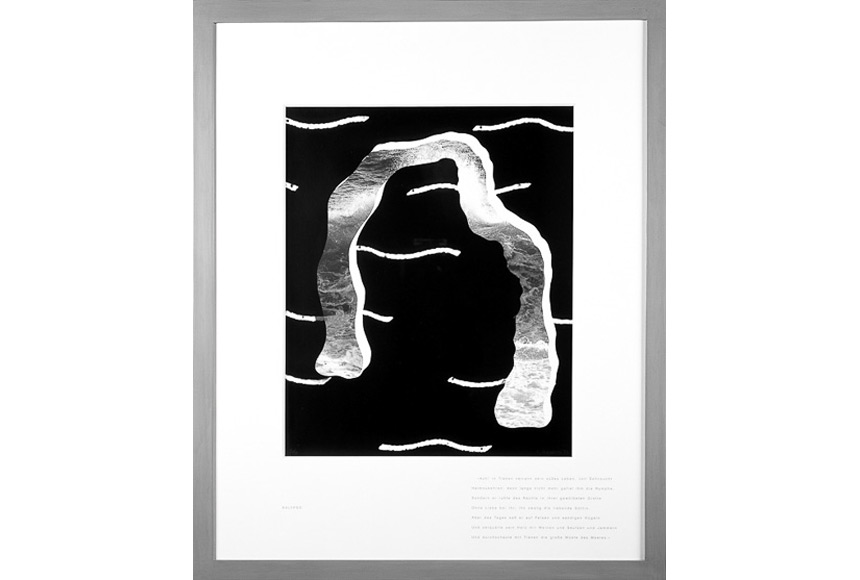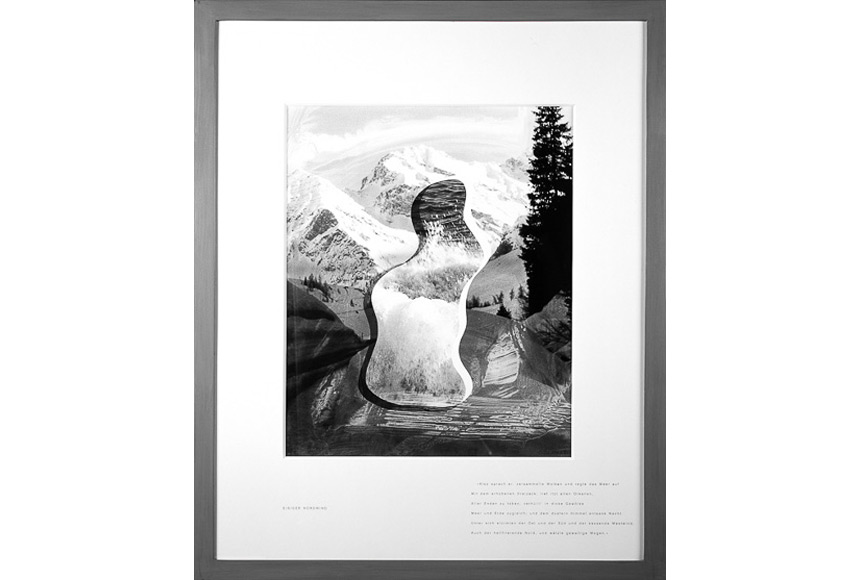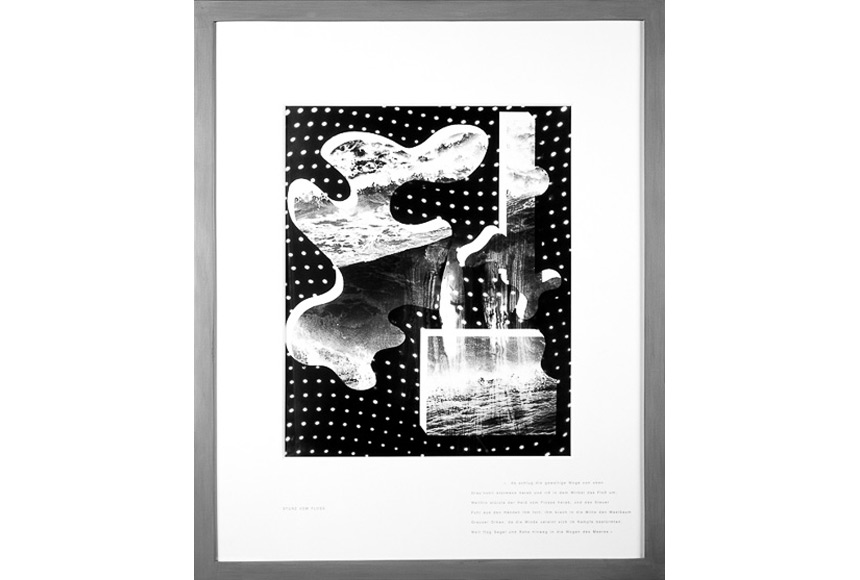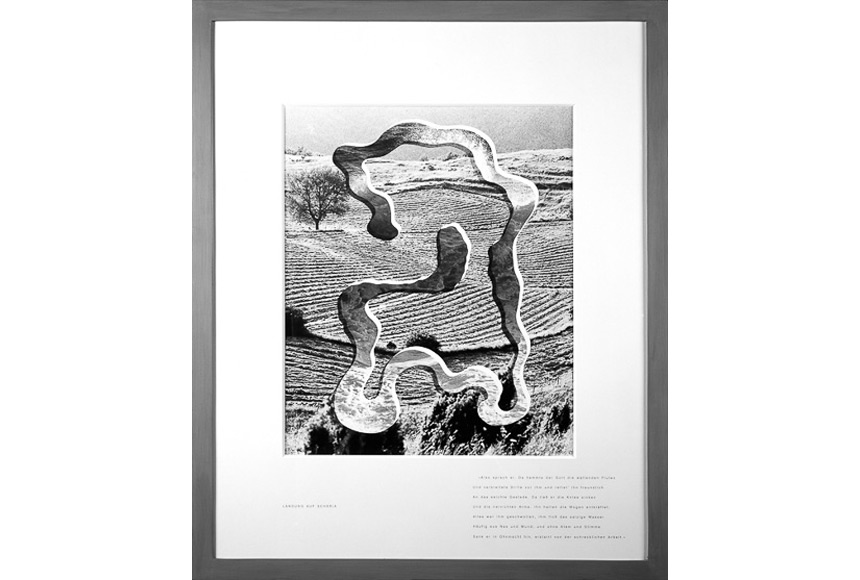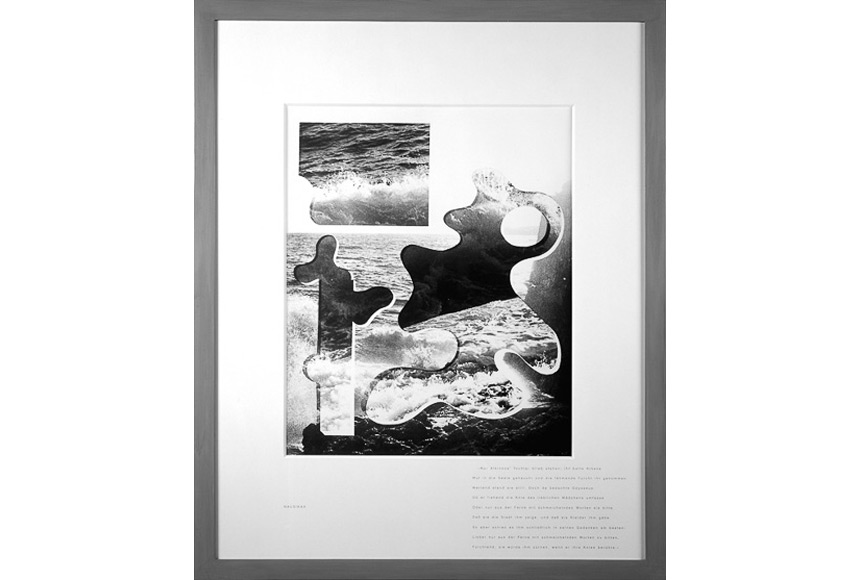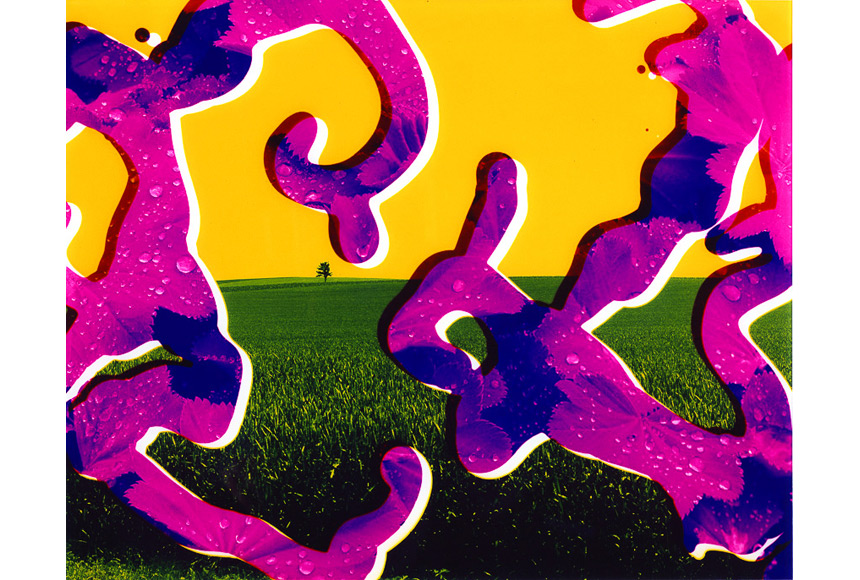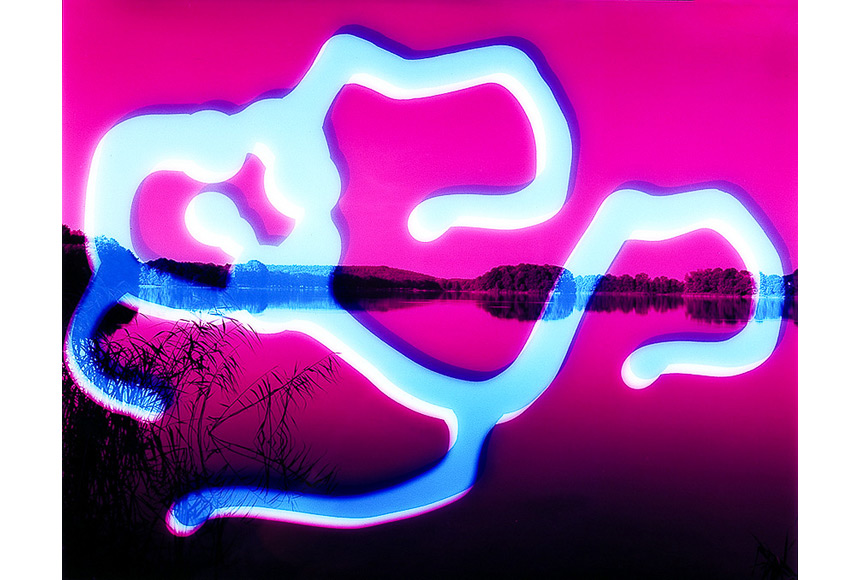english version below
Imaginäre Skulpturen
„In Caroline Dlugos‘ Fotoarbeiten ist Natur nicht mehr der Ort der Welterfahrung, der Einsamkeit oder Kontemplation, sondern ein Platz der Arbeit und der Produktion, denn auf ihren Bildern erscheinen immer wieder gepflügte Äcker, schnurgerade Baumreihen und monokultivierte Wälder. Auch ist sie der Schauplatz fotografischer Arbeit, und deshalb sollte man im Zusammenhang dieser Kunstwerke besser nicht mehr von Natur sondern eher von Umwelt sprechen, da auch das Fotografieren einen Zugriff und die Eroberung des Raumes mit visuellen Mitteln darstellt.Caroline Dlugos‘ Fotobilder entstehen in einem Prozeß des Überarbeitens. Die Künstlerin wählte für ihre Aufnahmen Landschaftsausschnitte der Berliner Umgebung, genauer gesagt aus den Urstromtälern der Mark Brandenburg, über die ein weitgereister Dichter einmal gesagt hat, daß Gott eingeschlafen sei, als er sie erschaffen habe.
Da uns die Welt weitgehend durch reproduzierte Abbilder der Wirklichkeit vermittelt wird, um sich dann mit der von uns unmittelbar physisch erlebten Wirklichkeit untrennbar zu vermischen, sieht Caroline Dlugos das fotografische Abbild bereits als einen Teil der erstgradigen Wirklichkeit an und behandelt es deshalb wie einen Werkstoff, den sie nach subjektivem Ermessen formen kann. Insofern ist die Landschaft für die Künstlerin nichts als ein Experimentierfeld: Die Raumillusion des fotografischen Abbildes soll durch die »Imaginäre Skulptur«, die wie eine mit Fototapete beklebte, ausgesägte Spanplatte in der Landschaft steht, ad absurdum geführt werden. Die räumliche Skulptur ist wieder eine Fläche und das Bild im Bild ist lediglich ein Ausschnitt des eigentlichenBildes.“ […]
Peter Funken, Ausstellungskatalog „Interferenzen III, Naturlandschaft Kunstlandschaft“ Museum moderner Kunst Wien, 1991
—————
„In der Verknüpfung von Mikro- und Makroebene weitet Caroline Dlugos unseren Blick, belässt das Bild aber in dem ihm gemäßen hermeticum, um es nicht zur literarisierbaren Fassade verkommen zu lassen. Bewältigung und Entzifferung von Welt weiß sie voneinander zu scheiden, Landschaften werden in ihren Bildern nicht abgebildet, sondern entfaltet. Sie lässt sich ein auf den Moment im Augenblick des Ganzen und kontrastiert ihn mit seiner eigenen Doppelbödigkeit und Unbestimmtheit. Raum und Zeit mischen sich in den „Imaginären Skulpturen“ in der Überschneidung von Gesehenem und Vorgestelltem. […]
Das visuelle Modell, das der Bildstrategie der Künstlerin zugrunde liegt, ist eines der ästhetischen Dialektik, die auf den Ausgleich zielt. Fotografiegeschichtlich steht Caroline Dlugos weniger bei den Laboranten , obwohl ihre experimentelle Leitlinie auch eine der Überraschung der Filmschicht ist. Ich zähle die Künstlerin eher zu den formalen Grammatikern, die die Bildkontrolle höher veranschlagen als einen chemigrafischen Eingriff. In Bezug auf den Authentizitätsanspruch, den man der Fotografie nachsagt, ist sie weder eine Dokumentaristin noch an detailkundiger Erörterung interessiert. Nah- und Fernsichten sind vielmehr suggestive Belege theoretischer Neugierde nach Raum- und Zeitverhältnissen in der Kunst. […]
Caroline Dlugos ist tatsächlich über die märkischen Äcker gefahren, aber nur, um das Gesehene bzw. das im Apparat Gespeicherte zum Ausgangspunkt zu machen für ein bildhaftes Nachdenken über Raum- und Kausalitätsvorstellungen. Wie eine Bildhauerin unterscheidet Caroline Dlugos Positiv- und Negativ-Formen. Mit Hilfe eines kalkulierten Zufallsverfahrens schafft sie der organischen Form der Landschaft einen Bezug durch einen tropfenförmigen Partikel, der wie eine „Imaginäre Skulptur“ durchs Bild zu gleiten scheint.“
Christoph Tannert, Duales Konzept, zitiert aus Ausstellungskatalog „Caroline Dlugos, Imaginäre Skulpturen“ , Kunstamt Berlin-Tempelhof, Berlin, 1992
—————
English versions of the two catalog texts:
“In Caroline Dlugos‘ photographs nature is no longer a place for experiencing the world, for aloneness or contemplation, but rather a location of work and production, as again and again her photographs show ploughed fields, perfectly straight rows of trees and forest monocultures. In addition it is also a place where photographic work goes on, and for this reason in the context of these works one should speak perhaps not so much of nature as of the environment since photography also represents a form of access and of the conquest of space by visual means.
Caroline Dlugos‘ photographic pictures have been created bya process of reworking. For her photographs the artist chose sections of the landscape around Berlin, or to be more precise, of the glacial valleys of Brandenburg, about which a widely travelled poet once said that after creating them God fell asleep. Since the world is communicated to us largely by means of reproduced images of reality which then merge inextricably with the reality that is directly and physically experienced by us, Caroline Dlugos views the photographic image as apart of the primary reality and treats it as a raw material that she can shape according to her own subjective discretion. In these works landscape is therefore nothing but a field of experimentation for the artist: The spatial illusion of the photographic image is carried to absurdity by means of the „imaginary sculpture“ which stands in the landscape like some sawed-out piece of chipboard covered with a wallpaper mural of alandscape. The spatial sculpture is itself a surface and the image within the image is only a detail of the image proper.“ […]
Peter Funken, quoted from exhibition catalog „Interferenzen III, Naturlandschaft Kunstlandschaft“ Museum of modern Art Vienna, 1991
(translated from the German by Maria E. Clay)
—————
„By associating both micro and macro planes, she broadens our outlook, but leaves the image in the hermeticum to which it is suited, so preventing it from degenerating into a facade too easily couched in empty terms. She knows how to distinguish between the assimilation and the decipherment of the world, in her pictures landscapes are not reproduced, they unfold. She entertains the moment in abriefglimpse of the whole and contrasts it with its own ambiguity and indeterminateness. In her work, time and space combine with the overlapping of the seen and the imagined. […]
The visual model which lies at the basis of the artist’s pictorial strategy is one of aesthetic dialectics, aiming for balance. In the history of photography, Caroline Dlugos can be classified less with the laboratory technicians, although her experimental guideline is also one of unexpected effects on the lamina of the film. I would classify the artist as one of the formal grammarians, who consider control over the picture more significant than interference in chemical processing. As for the pretension to authenticity which photographers are said to have, she is neither a documentarist nor is she interested in the discussion of detail. On the contrary, close-ups and distant shots are suggestive proofs of a theoretical inquisitiveness into the relationships of space and time in art. […]
Caroline Dlugos did indeed drive across the fields of the Mark Brandenburg, but only in order to make what she saw or what was stored in the camera the starting point for graphic consideration of the concepts of space and causality. Like a sculptress, Caroline Dlugos differentiates between positive and negative forms. With the aid of a calculated ‚chance‘ pro-cess, she creates a reference for the landscape ’s organic form by means of a dropshaped particle which appears to glide through the picture like an „Imaginary Sculpture“.
Christoph Tannert, Dual Conzept, quoted from exhibition catalog „Caroline Dlugos, Imaginary Sculptures“ Berlin, 1992, published by Kunstamt Berlin-Tempelhof, Berlin, 1992
(translated from the German by Lucinda Rennison)
[…] Landschaft
Für mich als geborene West-Berlinerin war Landschaft von jeher etwas exotisches, konstruiertes, nur auf Reisen zu besichtigen und nachträglich beim Dia-Abend zu Hause.
1988 begann ich die Serie „Imaginäre Skulpturen“. Die ersten Arbeiten der Serie (Arbeitstitel: Wasser-Puzzels) handelten thematisch von der Odyssee. Natur als mystische Urgewalt, als personifizierte, launenhafte Bedrohung oder Rettung. Das fotografische Ausgangsmaterial bestand ausnahmslos aus banalen Urlaubsfotos: Cote d’Azur, Davos, Toscana. Inhaltlich beschäftigten mich Experimente mit dem Ausschnittcharakter von Fotografie, der mir erlaubte, eine formlose, fließende Materie in eine scheinbar stabile dreidimensionale Form zu transformieren und damit die fotografischen Bildkomponenten Raum, Zeit und Authentizität ad absurdum zu führen.
Skulptur und Fotografie
Klassische Skulptur und Fotografie haben gemein, dass Teile aus einem bestehenden homogenen Ganzen herausgelöst werden, dass der ausgesparte Raum Teil des Werkes ist und das beide sich mittels Umkehrvorgängen aus Positiv und Negativ entwickeln.
Zufall
Alles ist Zufall – nichts ist Zufall.
Der fotografische Ausschnitt ist ein zufälliger Ausschnitt. Seine rechteckige Form verdanken wir den Kamerakonstrukteuren. Ein fotografisches Bild könnte, technisch gesehen, dem Objektiv entsprechend auch rund sein, inhaltlich gesehen könnte es auch aus jeweils zwei oder mehr Ausschnitten bestehen. Einer könnte zum Beispiel das Wollen abbilden und der andere das Müssen, das Suchen und das Finden, den Traum und die Wirklichkeit usw.
Ort
Ich war noch nie in der Mark Brandenburg obwohl ich die meiste Zeit meines Lebens in der Mark Brandenburg gelebt habe. […]
Aus: „Imaginären Skulpturen“ Künstlerstatement, Caroline Dlugos, Berlin, 1990
